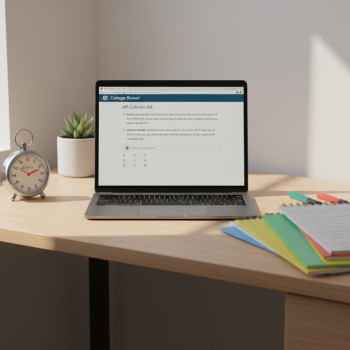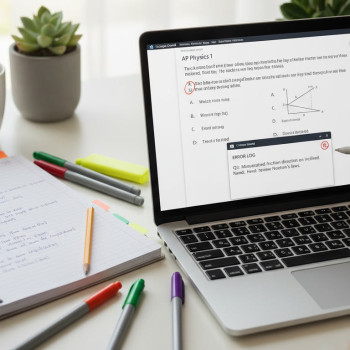Why This Conversation Matters: Boundaries, Accountability, and Your AP Student
Watching your child juggle Advanced Placement courses is a lot like watching them learn to ride a bicycle on a slightly steeper hill: thrilling, worrisome, and full of wildly unpredictable moments. You want them to get to the finish line—ideally upright—while also learning how to steer themselves. Too much of one thing (micromanagement) and you’ll stunt their independence; too much of the other (hands-off laissez-faire) and the grade report will make your stomach drop.
This post is written for parents who are determined to strike the right balance: not policing every minute but also not sitting by while opportunities slide. We’ll call that balance the middle path—practical, sustainable, and focused on long-term growth rather than short-term compliance. You’ll find concrete steps, examples, discussion prompts to use with your teen, a sample plan, and a table you can adapt for a weekly rhythm. Along the way, we’ll occasionally point out how personalized 1-on-1 tutoring—like Sparkl’s personalized tutoring with tailored study plans and expert tutors—can fit naturally into the plan when targeted help is needed.
Understanding the Two Poles
Before we map the middle path, let’s define the poles we’re balancing:
- Boundaries are the structures you set: study hours, screen rules, bedtimes, and expectations about chores and health. Good boundaries create safety and predictability.
- Accountability is about responsibility and consequences: grades, follow-through on commitments, and self-reporting. It’s how teenagers learn cause and effect.
Neither is bad. The problem arises when each is applied without nuance. Rigid boundaries without accountability can become authoritarian and brittle. Accountability without boundaries can feel like abandonment—’Figure it out or fail.’ The middle path blends both: clear structures plus escalating, fair accountability that teaches autonomy.

Principles of the Middle Path
Here are five guiding principles that shape a middle-path approach for AP parents.
1. Shared Ownership
Make studying a shared project, not a parental takeover. Invite your teen to co-create the study plan. When students have input, they’re far likelier to follow through.
2. Short, Measurable Goals
Replace vague expectations (“study more”) with small, measurable wins (“review 20 AP Chemistry flashcards daily” or “complete 1 past AP exam section on Saturday”). Measure progress weekly, not just by final exam scores.
3. Predictable, Graduated Consequences
Consequences should be known in advance and proportionate: missed practice earns extra practice, not punitive shutdowns. The goal is learning, not punishment.
4. Emotional Safety First
AP pressure can push students into anxiety loops. The middle path keeps lines of communication open—no shaming, no gaslighting. Mistakes are data, not indictments.
5. Use Expert Help Strategically
One-on-one tutoring is not a crutch when used for specific gaps. Targeted sessions—say, two to four focused hours a week—can accelerate skill-building, restore confidence, and reduce household friction. For families who want a structured supplement, Sparkl’s personalized tutoring offers tailored study plans, expert tutors, and AI-driven insights that integrate with a student’s routine without taking it over.
How to Build a Middle-Path Study System: Step-by-Step
Below is a step-by-step process you can implement this week. It’s intentionally lightweight so you can adopt it without a household summit.
Step 1 — A 30-Minute Planning Conversation
Schedule a neutral time (not right after a bad grade) for a short planning talk. Use these prompts:
- “What do you feel confident about in this class?”
- “Where do you hit stalls or confusion?”
- “What kind of help works best for you—short sessions with a peer, a tutor once a week, or a study guide?”
Keep the tone collaborative. You’re a coach, not a drill sergeant.
Step 2 — Co-create a Weekly Plan
Limit the planning to one page. Include study blocks, health habits, and a built-in review of progress. Here’s a simple template—adaptable to any AP subject.
Step 3 — Micro-Checkpoints, Not Micro-Management
Instead of hovering over every study minute, schedule three short checkpoints per week: a Monday setup (what’s the plan?), a midweek check-in (what worked? what didn’t?), and a Sunday review (what to keep or change?). These are 10–15 minute conversations—low friction, high signal.
Step 4 — Calibrated Support
If your teen repeatedly misses goals because of content gaps, escalate support by subject. Two targeted options work well:
- Short, focused tutoring sessions for the weakest topics—2–4 sessions a week for a month.
- Skill-focused practice—timed past AP sections, spaced repetition flashcards, and concept maps.
Personalized tutoring, like Sparkl’s tailored approach, can slot in here: expert tutors help diagnose gaps and provide a study plan that complements school instruction and your household rhythm.
A Realistic Weekly Template
Below is a sample weekly template you can paste into a family planner or print out and adjust. It reflects the middle path: set boundary (study blocks), accountability (goals & checks), and supports (tutoring, rest).
| Day | Morning | Afternoon | Evening | Mini-Goal |
|---|---|---|---|---|
| Monday | Quick review (15m) flashcards | School + 30m concept notes | 30–45m focused study block | Finish 1 topic review |
| Tuesday | Brief problem warm-up (10m) | School + AP class focus | Homework + 30m practice | Complete 1 practice problem set |
| Wednesday | Sleep-friendly wake & review | School + ask teacher 1 quick question | Midweek check-in with parent (10–15m) | Clarify 1 confusing concept |
| Thursday | Targeted flashcards (15m) | School | Tutor session or targeted review (if scheduled) | Attend 1 tutor-recommended task |
| Friday | Light review | School + lighter load | Rest, hobbies, social time | Recharge (no heavy study) |
| Saturday | Timed past AP section (60–90m) | Review mistakes with notes | Family time and sleep | Analyze 1 practice section |
| Sunday | Weekly review (20m) | Plan next week with parent (10–15m) | Prep materials for Monday | Finalize goals and rest |
Accountability That Teaches, Not Controls
Accountability should be designed to teach decision-making. That means shifting from external consequences to natural, logical ones and helping the teen reflect on results. Below are progressive accountability levels you can use and adapt.
- Tier 1 — Natural Reminders: Parent reminders about agreed blocks. Low intensity—use when compliance is generally good.
- Tier 2 — Structured Check-ins: Quick weekly reviews where the student summarizes wins and struggles. Use this if patterns begin to emerge.
- Tier 3 — Skill Interventions: If grades fall because of content gaps, introduce targeted tutoring or study groups. This is where professional help (like 1-on-1 tutoring) becomes a learning tool, not a punishment.
- Tier 4 — Negotiated Consequences: If commitments are repeatedly ignored, negotiate a consequence related to the missed responsibility (e.g., loss of leisure time until the missed practice is completed). Keep it proportional and restorative—focus on making up the lost learning time.
Example Conversation Framework for Check-Ins
Use this short script during a 10-minute weekly review. It keeps the tone non-confrontational and solution-focused:
- Parent: “Tell me one thing that felt good about studying this week.”
- Student: (answers)
- Parent: “What was the hardest part?”
- Student: (answers)
- Parent: “What one small change this week would make that easier?”
End by summarizing the agreed change and the measurable micro-goal for next week.
When to Bring in Personalized Tutoring
Tutoring is most effective when it targets the right gaps at the right time. Consider tutoring when any of these are true:
- Your teen consistently misunderstands the same concept despite classroom instruction.
- Practice test scores plateau or decline after a period of good effort.
- Motivation drops because of repeated failure—tutors can rebuild confidence quickly.
One-on-one tutoring offers several advantages that align with the middle path: targeted diagnosis, tailored lesson plans, real-time feedback, and strategies to build independent study habits. If you choose a tutoring route, communicate it as an empowerment tool—not as punishment. Mention that the goal is to reduce stress and foster competence; a structured tutoring plan can shorten the learning curve and free up family time.
Sample Case Studies (Short, Realistic Scenarios)
Case 1 — Emma: The Overloaded Sophomore
Emma is taking AP Biology and feels her workload is crushing her spring semester. She’s setting unrealistic study hours and burning out. The family implemented the middle path by co-creating a reduced, consistent weekly plan (three focused 45-minute sessions plus one tutor session a week). Emma regained energy, showed steady improvement on practice quizzes, and reported less anxiety.
Case 2 — Malik: The Procrastinator
Malik tends to cram and misses the benefits of spaced practice. Parents supported him by adding micro-checkpoints and a predictable weekend timed-practice. They escalated to Tier 3 accountability when one month of checks didn’t help, securing two targeted tutoring sessions focused on time management and problem decomposition. Malik learned a strategy for breaking tasks into 20–30 minute sprints and improved his practice test pacing.
Common Pitfalls and How to Avoid Them
- Micromanaging Study Minutes: Avoid logging every minute. Instead, focus on outcomes and consistent routines.
- Confusing Rigid Rules with Security: Teenagers need some flexibility—punitive rigidity often backfires.
- Waiting Until Crisis: Don’t wait until a major grade dip to change course. Small course corrections are easier and less stressful.
- Shaming After Failure: Treat mistakes as information. Ask what to change, not who to blame.

Tools and Rituals That Support the Middle Path
Not every family needs complicated tracking software. Here are simple, low-friction tools and rituals that often lead to big returns:
- Weekly planning meeting (10–15 minutes) with a printed one-page plan.
- Timer-based study sprints (25–45 minutes) with 5–10 minute breaks.
- Lightweight accountability log: three bullet points each day—what was done, one win, one question.
- Monthly learning review: look at practice test trends and adjust targets.
These rituals preserve autonomy while adding systemic guardrails—exactly the middle path you’re trying to create.
Measuring Progress Without Crushing the Spirit
Grades and practice tests matter, but so do soft signals. Here are metrics to track, ordered from least to most formal:
- Daily mood and study energy—does the student feel burned out?
- Consistency of study habits—are blocks happening most days?
- Practice test scores for trend direction rather than single-test fixation.
- Teacher feedback on conceptual understanding and participation.
Celebrate small wins (a clearer explanation from a teacher, a practice score improvement) and let setbacks be diagnostic. If trends stall for more than a few weeks, it’s time to intensify support—tutoring, reworked study plans, or session with the teacher.
Scripts for Tough Moments
Here are short scripts for common, tense moments that maintain the middle-path tone.
If a teen resists a check-in
“I hear you. This won’t be long—just ten minutes to see if there’s something we can change to make studying less awful. If you still want to skip after, that’s fine, but I’d like us to try one small fix together.”
If a missed goal keeps repeating
“We agreed last week you’d finish two practice sets and it didn’t happen. Help me understand what got in the way. If the work is too hard, we can get help. If it’s time management, let’s try a different schedule.”
If stress is overwhelming
“Your health matters more than any score. Let’s talk to your counselor or get a short tutor plan just to clear the immediate confusion so school feels manageable again.”
Putting It All Together: A 6-Week Starter Plan
Here’s a compact six-week plan to move from friction to flow. Treat it as an experiment and iterate.
- Week 1: Planning conversation and co-created weekly template. Start simple with three focused study blocks and one midweek check-in.
- Week 2: Add micro-checkpoints and begin a lightweight daily log (3 bullets/day). Observe where time disappears.
- Week 3: Review practice-test trends. If gaps appear, schedule 2–3 targeted tutor sessions. If motivation falters, add a reward ritual (family movie night after a week of completed goals).
- Week 4: Reassess boundaries—tighten or loosen based on energy and results. Continue tutoring if still needed; focus on independent practice between sessions.
- Week 5: Simulate a timed section or practice exam under realistic conditions. Review mistakes with student-led explanations.
- Week 6: Finalize a sustainable rhythm for the next cycle. Celebrate progress and recalibrate goals for the coming month.
Final Thoughts: The Long Game
Parenting an AP student is a marathon, not a sprint. The middle path of boundaries plus accountability prioritizes learning over compliance and independence over control. It asks you to be a steady coach: set structures that protect learning time, hold students to fair and teachable consequences, and bring in help—like targeted 1-on-1 tutoring—when it accelerates growth without eroding student agency.
When you step back and look at the broader arc, what matters most is not any single test score but the student’s ability to manage complex workloads, ask for help, and recover from setbacks. Those are the skills that carry well beyond high school.
A Parting Note
If you’re unsure where to start, begin with one small experiment: a 30-minute planning conversation this week and a single, measurable micro-goal for the next seven days. See how it feels. If content gaps emerge or confidence dips, consider a short tutoring burst—targeted support can restore momentum quickly and make your middle-path plan easier to live with.
You’re not alone in this. With predictable boundaries, thoughtful accountability, and compassionate support, your teen can grow into the kind of independent learner colleges and life value. Enjoy the journey—warts and all—and remember: progress is often messy, but it’s worth it.



















No Comments
Leave a comment Cancel